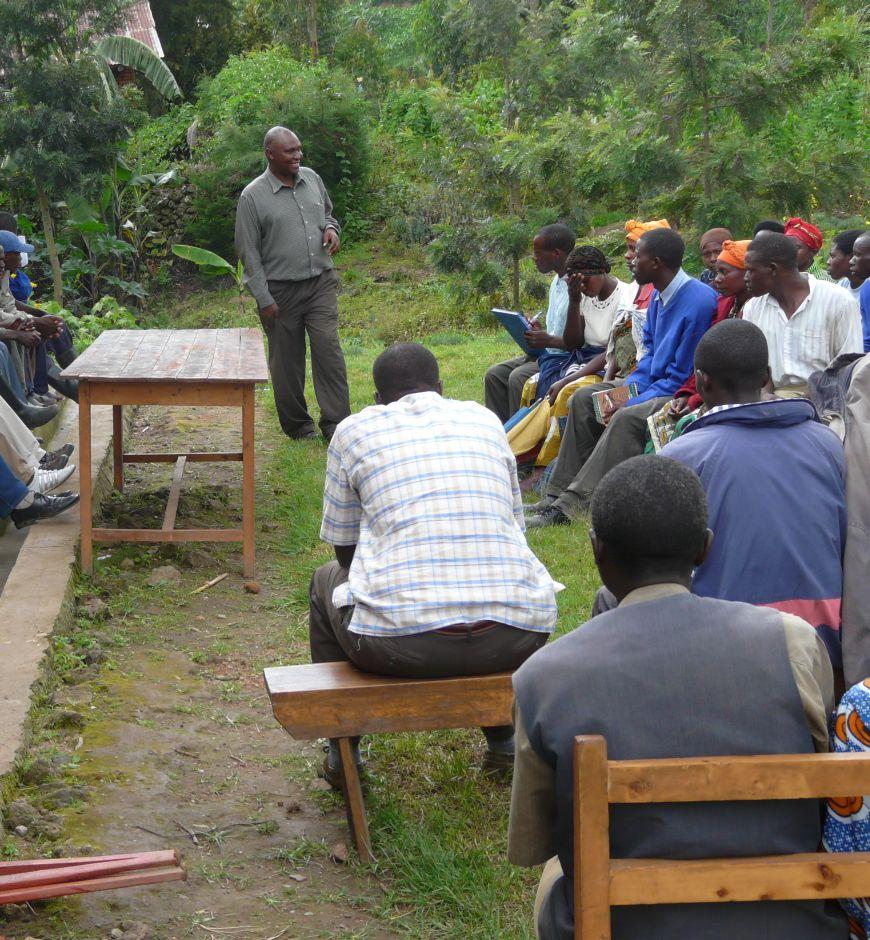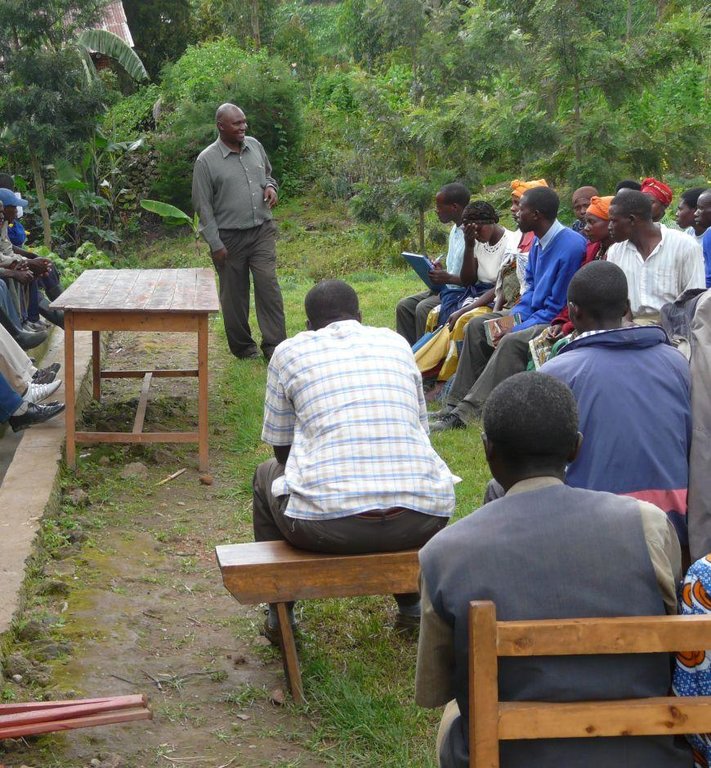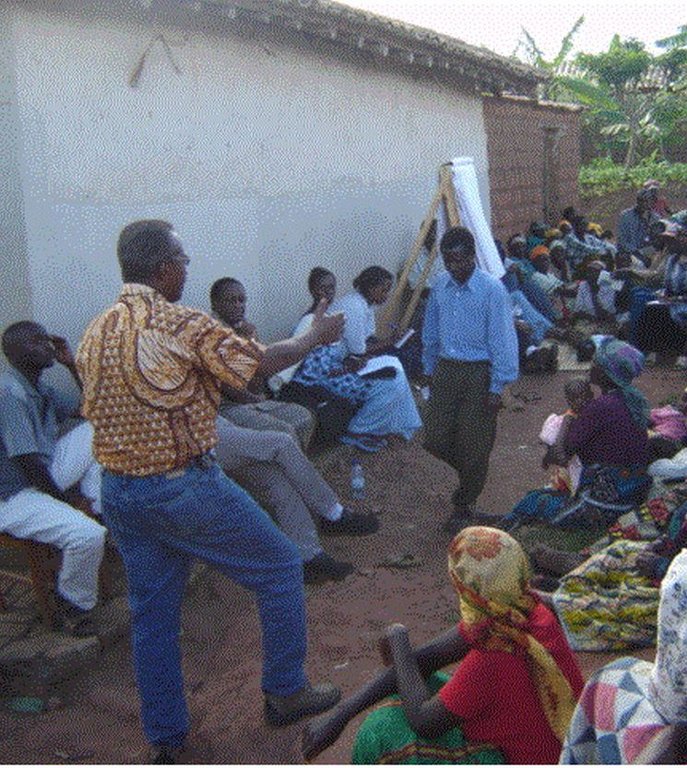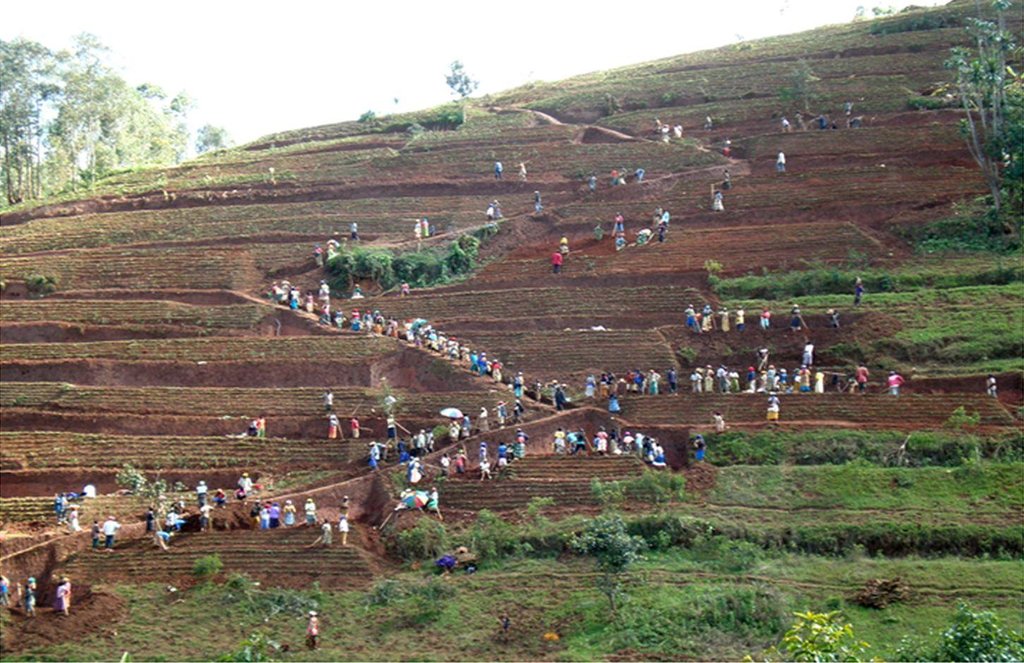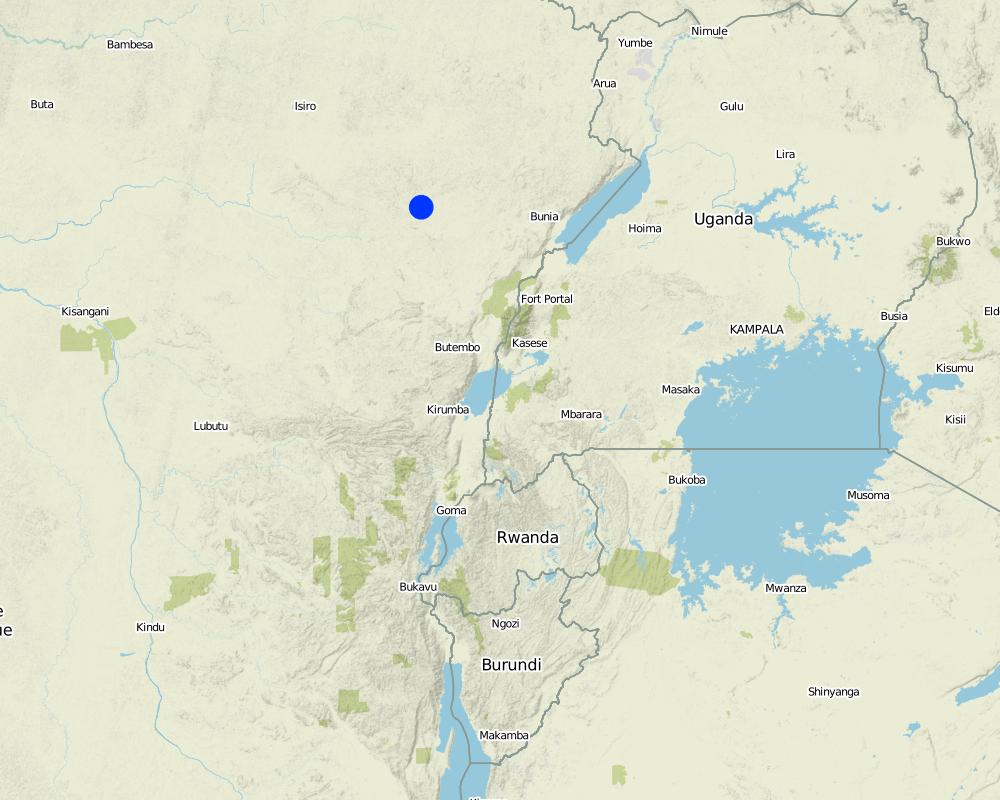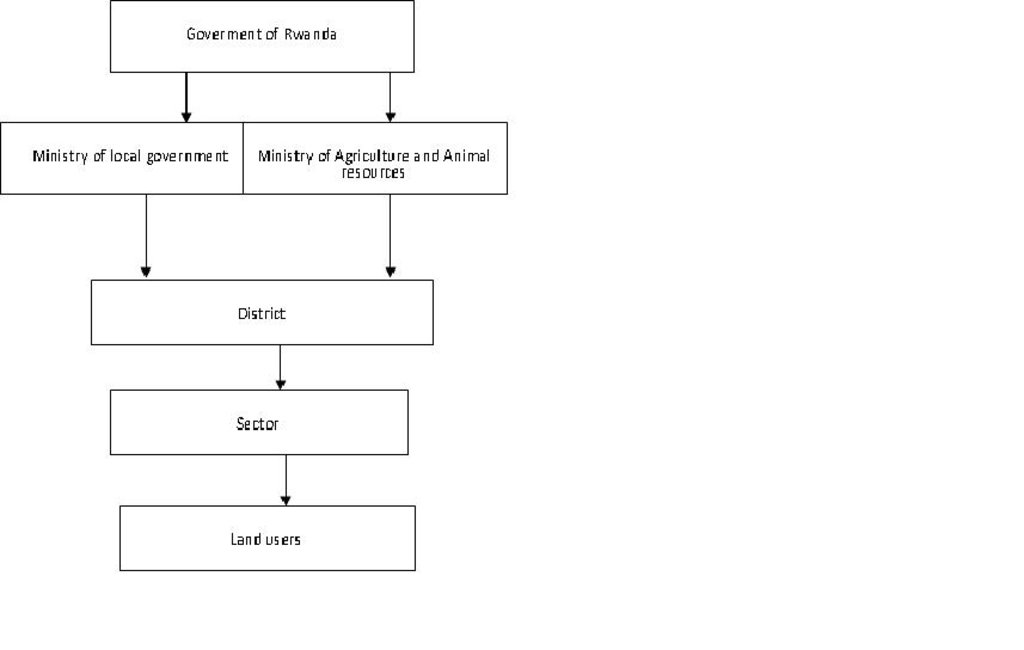Top down approach [Rwanda]
- Création :
- Mise à jour :
- Compilateur : Desire Kagabo
- Rédacteur : –
- Examinateur : David Streiff
Amabwiriza aturutse ibukuru
approaches_2465 - Rwanda
Voir les sections
Développer tout Réduire tout1. Informations générales
1.2 Coordonnées des personnes-ressources et des institutions impliquées dans l'évaluation et la documentation de l'Approche
Spécialiste GDT:
Nom du projet qui a facilité la documentation/ l'évaluation de l'Approche (si pertinent)
The Transboundary Agro-ecosystem Management Project for the Kagera River Basin (GEF-FAO / Kagera TAMP )Nom du ou des institutions qui ont facilité la documentation/ l'évaluation de l'Approche (si pertinent)
Rwanda Agriculture Board (Rwanda Agriculture Board) - RwandaNom du ou des institutions qui ont facilité la documentation/ l'évaluation de l'Approche (si pertinent)
Food and Agriculture Organization of the United Nations (FAO) - Italie1.3 Conditions relatives à l'utilisation par WOCAT des données documentées
Quand les données ont-elles été compilées (sur le terrain)?
01/01/2011
Le compilateur et la(les) personne(s) ressource(s) acceptent les conditions relatives à l'utilisation par WOCAT des données documentées:
Oui
1.4 Références au(x) questionnaire(s) sur les Technologies de GDT
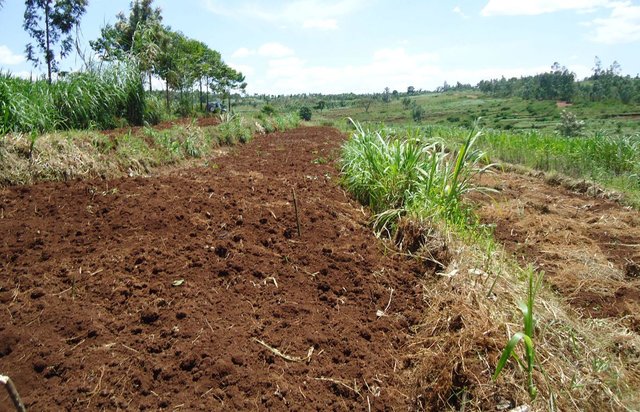
Radical Terraces [Rwanda]
Locally referred to as ‘radical terracing’, the method involves earth moving operations that create reverse-slope bench terraces which have properly shaped risers stabilized with grass or trees on embankment to avoid collapse.
- Compilateur : Desire Kagabo
2. Description de l'Approche de GDT
2.1 Courte description de l'Approche
This is a top down approach to technology development and dissemination with limited involvement of intended beneficiaries.
2.2 Description détaillée de l'Approche
Description détaillée de l'Approche:
Aims / objectives: The objective of the top down approach is to assign the state a crucial role to drive a designed rural development and land management master plan that needs people to implement it.
To bring farmers together to address an identified problem such as to improve the socio economic situation of rural areas, to prevent , to conserve and to rehabilitate on-site damages caused by land degradation and erosion.
Methods: The top down approach here refers to the level of farmer participation in relation to shared decision making when establishing bench terraces/soil conservation practices in Rwanda. The focus being particularly on the role of farmers in the decision making process during two major phases of the process of terrace construction including: (1) when and where to construct bench terraces in communities and the criteria for site and beneficiary selection. The level of farmer participation and decision sharing have the potential of in increasing the ownership of the of the existing or future bench terraces, hence to ensure its sustainability. Recent studies assert that most of the terraces that are constructed are supply driven and that farmers do not participate in the decisions regarding where and when to construct them. When farmers do participate, it is mostly only through some consultation and their own efforts to mobilize collective labor for the construction of the terraces.
Stages of implementation: Stage one comprises the analysis of current or initial adoption decisions of soil conservation practices, while stage two assesses farmers’ ability to continue the use of these practices. Stage three analyses future adoption proxied by farmers’ willingness to uptake more soil conservation practices.
Role of stakeholders: The state plays a prime role in bench terraces development and the role of other stakeholders (e.g. extension agents, farmer associations) is marginal. Farmer associations involvement is is limited to mobilizing labor and, sometimes, to identifying land for terracing. Extension agencies/services are involved in providing advice to individual farmers or farmers grouped in cooperatives. Community representatives, whom are members of the farmers’ cooperatives themselves, are trained to provide additional support and advice to farmers.
Other important information: This SLM approach argues for a role of the state with top-down and coercive measures in the development of soil conservation practices, particularly bench terraces. Currently there is a two pronged approach based on the realization that bench terraces are ready made constructions which require substantial financial and institutional investments. Mustering labor and resources for the construction and maintenance of bench terraces remains a key aspect of the state’s conservation drive. State-farmer relationships, therefore, continue to be essential to soil conservation efforts in Rwanda and to bench terrace construction in particular.
2.3 Photos de l'approche
2.5 Pays/ région/ lieux où l'Approche a été appliquée
Pays:
Rwanda
Région/ Etat/ Province:
East
Autres spécifications du lieu :
Kayonza
Commentaires:
The area is not well known, it is approximately estimated
Map
×2.6 Dates de début et de fin de l'Approche
Indiquez l'année de démarrage:
1950
2.7 Type d'Approche
- government based
2.8 Principaux objectifs de l'Approche
The Approach focused mainly on SLM with other activities (Increase soil fertility, good practices of land management in general)
To raise awareness to land users for a particular problem and involve them to get to the right solution
The SLM Approach addressed the following problems: low agricultural production due to a poor agriculture practice and lack of technical knowledge by farmers
2.9 Conditions favorisant ou entravant la mise en œuvre de la(des) Technologie(s) appliquée(s) sous l'Approche
disponibilité/ accès aux ressources et services financiers
- entrave
terraces and trenches require high investment for establishment and maintenance.
Treatment through the SLM Approach: the government support and other local and Internationale NGOs is highly required
cadre juridique (régime foncier, droits d'utilisation des terres et de l'eau)
- favorise
- entrave
connaissances sur la GDT, accès aux supports techniques
- entrave
lack of technical knowledge and cohesion between farmers to address the main problem regarding agriculture in their location.
Treatment through the SLM Approach: implementation of agricultural cooperative
3. Participation et rôles des parties prenantes impliquées dans l'Approche
3.1 Parties prenantes impliquées dans l'Approche et rôles
- exploitants locaux des terres / communautés locales
Farmers
There were no limitation all farmers were involved
- Spécialistes de la GDT/ conseillers agricoles
- chercheurs
- gouvernement local
Local leaders
- gouvernement national (planificateurs, décideurs)
Parliament
3.2 Participation des exploitants locaux des terres/ communautés locales aux différentes phases de l'Approche
| Participation des exploitants locaux des terres/ communautés locales | Spécifiez qui était impliqué et décrivez les activités | |
|---|---|---|
| initiation/ motivation | aucun | |
| planification | aucun | |
| mise en œuvre | interactive | Land users and local authorities work together to get to greater result. |
| suivi/ évaluation | interactive | Land users are in daily interaction with Sector Agronomist who is in charge of all agricultural activities in the sector. |
| Research | aucun |
3.3 Diagramme/ organigramme (si disponible)
3.4 Prises de décision pour la sélection de la Technologie/ des Technologies
Indiquez qui a décidé de la sélection de la Technologie/ des Technologies à mettre en œuvre:
- les spécialistes de la GDT seuls
Expliquez:
Decisions were made in the ministry of agriculture after consultation of researchers.
Decisions on the method of implementing the SLM Technology were made by by politicians / leaders. Politicians have decided the way of implementation through community work known as UMUGANDA
4. Soutien technique, renforcement des capacités et gestion des connaissances
4.1 Renforcement des capacités/ formation
Une formation a-t-elle été dispensée aux exploitants des terres/ autres parties prenantes?
Non
4.2 Service de conseils
Les exploitants des terres ont-ils accès à un service de conseils?
Oui
Décrivez/ commentez:
Advisory service is quite adequate to ensure the continuation of land conservation activities
4.3 Renforcement des institutions (développement organisationnel)
Des institutions ont elles été mises en place ou renforcées par le biais de l'Approche?
- oui, modérément
Spécifiez à quel(s) niveau(x), ces institutions ont été renforcées ou mises en place:
- local
Précisez le type de soutien:
- financier
- renforcement des capacités/ formation
4.4 Suivi et évaluation
Le suivi et l'évaluation font ils partie de l'Approche? :
Oui
Commentaires:
bio-physical aspects were ad hoc monitored by government through observations; indicators: local leadres
bio-physical aspects were regular monitored by project staff, government through measurements; indicators: local agronomist
technical aspects were regular monitored by government through observations; indicators: local agronomist
technical aspects were regular monitored by government through measurements; indicators: local agronomist
socio-cultural aspects were None monitored by government through observations; indicators: local leaders
area treated aspects were None monitored by government through observations; indicators: local agronomist
area treated aspects were None monitored by government through measurements; indicators: all person of 18 years and above are involved
no. of land users involved aspects were None monitored by government through observations; indicators: None
no. of land users involved aspects were None monitored by government through measurements; indicators: None
management of Approach aspects were None monitored by government through observations; indicators: None
There were no changes in the Approach as a result of monitoring and evaluation: None
There were no changes in the Technology as a result of monitoring and evaluation: None
4.5 Recherche
La recherche a-t-elle fait partie intégrante de l’Approche?
Non
5. Financement et soutien matériel externe
5.1 Budget annuel de la composante GDT de l'Approche
Si le budget annuel précis n'est pas connu, indiquez une fourchette:
- 100 000-1 000 000
Commentez (par ex. principales sources de financement/ principaux bailleurs de fonds):
Approach costs were met by the following donors: government (planing): 20.0%; local government (district, county, municipality, village etc) (sensitization and follow up): 25.0%; local community / land user(s) (implimentation): 55.0%
5.2 Soutiens financiers/ matériels fournis aux exploitants des terres
Les exploitants des terres ont-ils reçu un soutien financier/ matériel pour la mise en œuvre de la Technologie/ des Technologies?
Oui
Si oui, spécifiez le(s) type(s) de soutien, les conditions et les fournisseurs:
inputs (seeds, fertilizers, etc..) provided by the Government
5.3 Subventions pour des intrants spécifiques (incluant la main d'œuvre)
- intrants agricoles
| Spécifiez les intrants subventionnés | Dans quelle mesure | Spécifiez les subventions |
|---|---|---|
| semences | entièrement financé | |
- matériaux de construction
| Spécifiez les intrants subventionnés | Dans quelle mesure | Spécifiez les subventions |
|---|---|---|
| material | en partie financé | |
Si la main d'œuvre fournie par les exploitants des terres était un intrant substantiel, elle était:
- volontaire
Commentaires:
After the sensitization by local leaders, activities are done voluntarily or with food-for-work by farmers.
5.4 Crédits
Des crédits ont-ils été alloués à travers l'Approche pour les activités de GDT?
Non
6. Analyses d'impact et conclusions
6.1 Impacts de l'Approche
Est-ce que l'Approche a aidé les exploitants des terres à mettre en œuvre et entretenir les Technologies de GDT?
- Non
- Oui, un peu
- Oui, modérément
- Oui, beaucoup
the approach helped in the implementation of technologies which improved crop production and soil conservation.
Did other land users / projects adopt the Approach?
- Non
- Oui, un peu
- Oui, modérément
- Oui, beaucoup
some project introduced new technology (e.g. one cow per family) with the help of local leaders
Did the Approach help to alleviate poverty?
- Non
- Oui, un peu
- Oui, modérément
- Oui, beaucoup
as the production increase, it increases as well the well being of farmers
6.2 Principale motivation des exploitants des terres pour mettre en œuvre la GDT
- augmenter la production
improve soil quality and crop production
- augmenter la rentabilité/ bénéfice, rapport coûts-bénéfices
as production increases this allows farmers to take a part of the production on market
- paiements/ subventions
low cost of inputs as they are provided by the government
- well-being and livelihoods improvement
as production and income increases, its facilitates farmers to access to all sanitary services, etc.
6.3 Durabilité des activités de l'Approche
Les exploitants des terres peuvent-ils poursuivre ce qui a été mis en œuvre par le biais de l'Approche (sans soutien extérieur)?
- incertain
Si non ou incertain, spécifiez et commentez:
It require a strong follow up
6.4 Points forts/ avantages de l'Approche
| Points forts/ avantages/ possibilités du point de vue de l'exploitant des terres |
|---|
| It help farmers to work together for a common issue. (How to sustain/ enhance this strength: continuous sensitization ) |
| Points forts/ avantages/ possibilités du point de vue du compilateur ou d'une autre personne ressource clé |
|---|
| Improvement of livelihoods (How to sustain/ enhance this strength: continuous sensitization) |
| farmers are getting benefits, as it has a direct impact in increasing the soil productivity and improve workability of the land (How to sustain/ enhance this strength: continuous sensitization ) |
| the approach helped to establish SLM measures which reduced soil erosion and improve soil quality (How to sustain/ enhance this strength: continuous sensitization) |
6.5 Faiblesses/ inconvénients de l'Approche et moyens de les surmonter
| Faiblesses/ inconvénients/ risques du point de vue de l’exploitant des terres | Comment peuvent-ils être surmontés? |
|---|---|
| lack of strong link in the farmers association and cooperatives | continuous sensitization |
| Faiblesses/ inconvénients/ risques du point de vue du compilateur ou d'une autre personne ressource clé | Comment peuvent-ils être surmontés? |
|---|---|
| High costs: farmers depend on external support from the government, they are not willing to invest their labour without payments. | To make the working time as short as possible for the community work so that farmer can plan other income activities after this. |
| lack of land users participation in the design and planing | involve all stakeholders |
7. Références et liens
7.1 Méthodes/ sources d'information
- visites de terrain, enquêtes sur le terrain
- interviews/entretiens avec les exploitants des terres
Liens et modules
Développer tout Réduire toutLiens

Radical Terraces [Rwanda]
Locally referred to as ‘radical terracing’, the method involves earth moving operations that create reverse-slope bench terraces which have properly shaped risers stabilized with grass or trees on embankment to avoid collapse.
- Compilateur : Desire Kagabo
Modules
Aucun module trouvé


